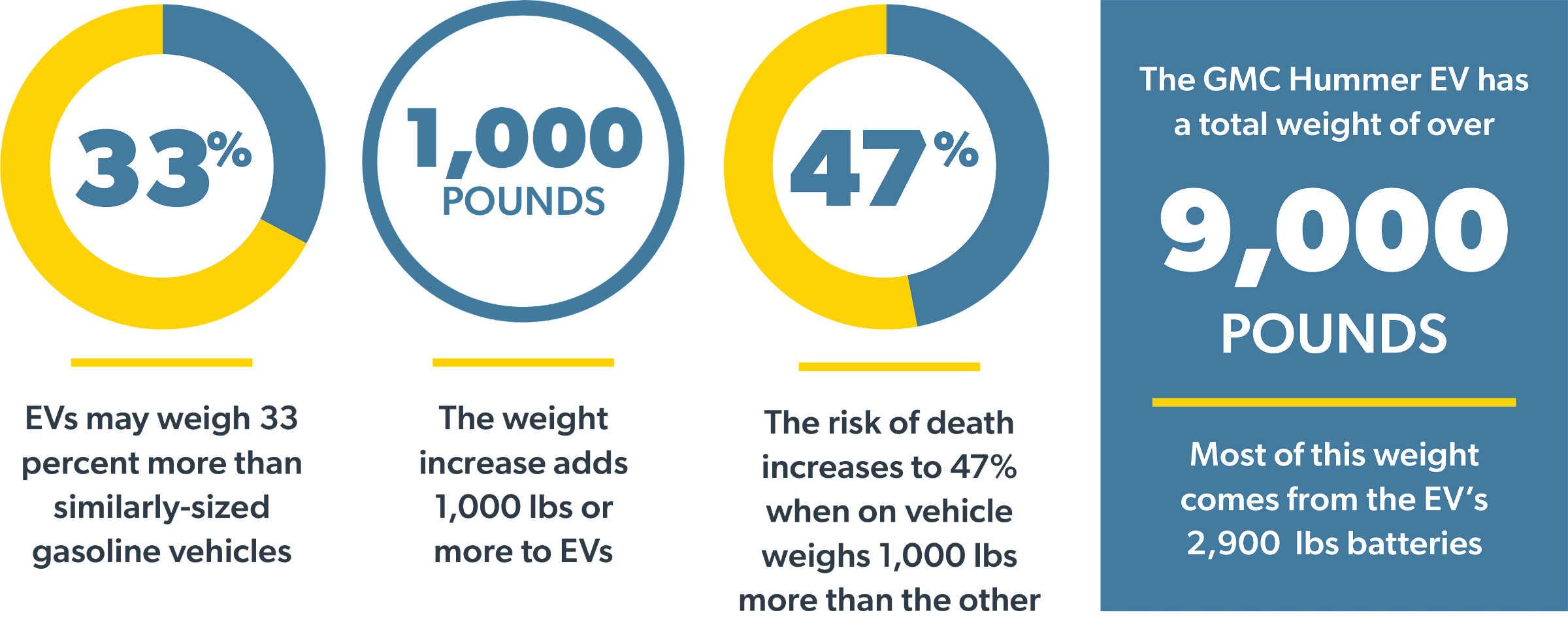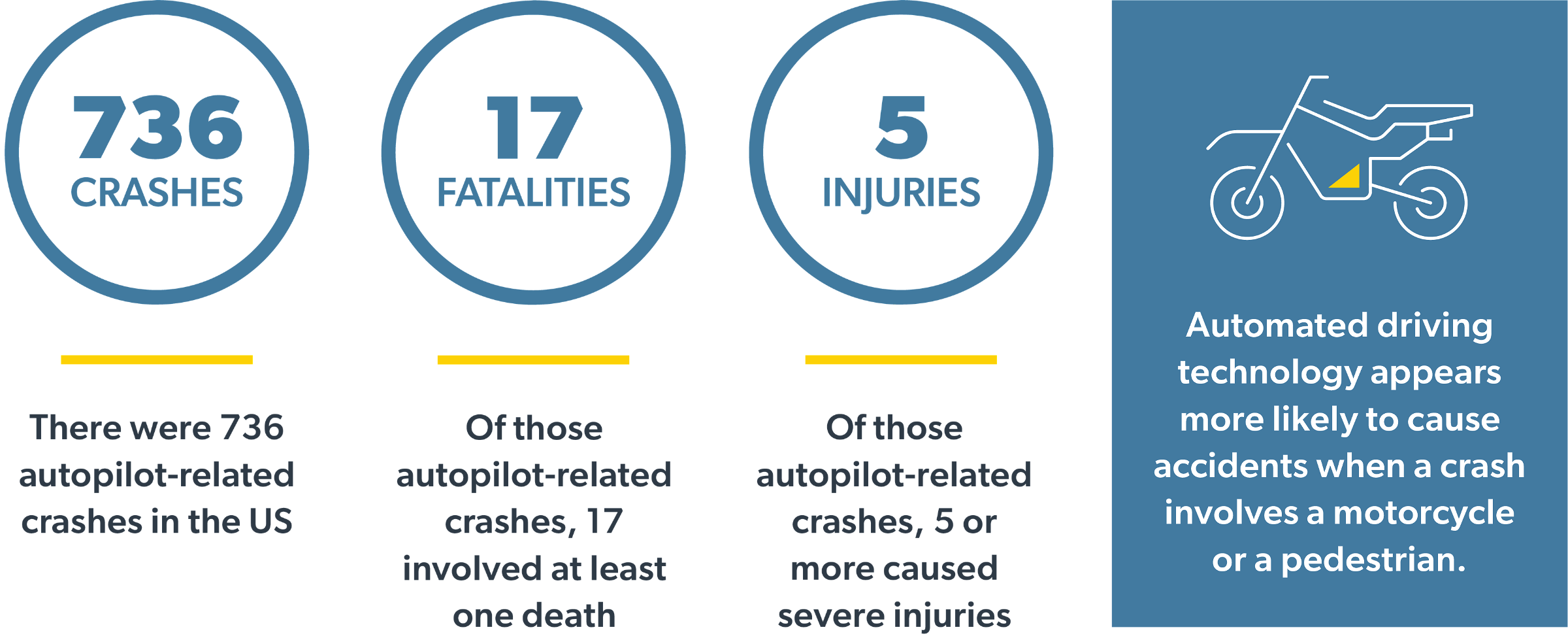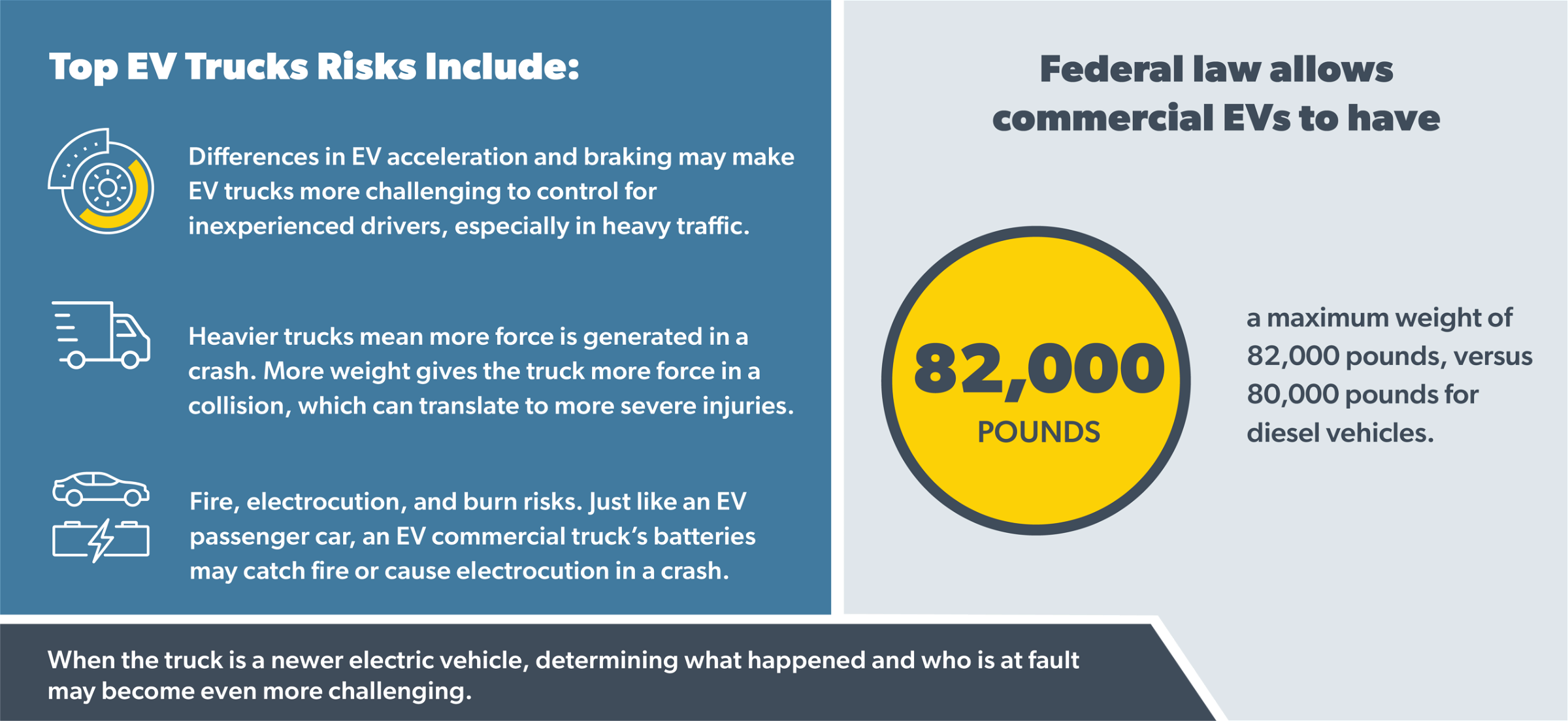ABSTRACT
EV-related crashes pose risks that automakers are yet to fully understand, despite the increasing popularity and benefits of electric vehicles.
Electric vehicles offer opportunities to reduce pollution and lower the costs of fueling vehicles while still making vehicle-based transportation convenient.
While the risks of gas-powered vehicle collisions are well known, however, the risks of EV vehicle crashes remain an area for study - and many risks are not fully understood.
Representing Injured People Since 1927
Trends in Electric Vehicle Accidents Impacting South Carolina Drivers
Electric vehicles are gaining rapid popularity as drivers look for environmentally friendly ways to reduce their transportation costs.
In 2013, automakers sold nearly 500,00 hybrid vehicles and 100,000 electric vehicles in the United States. In the United States, new electric car registrations totalled 1.4 million in 2023, increasing by more than 40% compared to 2022.
Electric vehicles offer several benefits compared to gasoline-powered vehicles. Marketing of EVs focuses on these benefits without discussing the potential risks of the new technologies. While electric vehicles do offer benefits to drivers and passengers, as well as to surrounding community air quality, they also pose risks during a crash - risks that automakers are just beginning to understand.
EV-Related Accidents in the US and South Carolina
While electric vehicles are becoming more popular, new EV registrations still made up less than 7 percent of all new vehicle registrations at the start of 2023. In total, EVs make up about one percent of all cars on US roads.
To date, statistics on EV accident injuries and deaths indicate that these vehicles are neither significantly more nor significantly less safe than gasoline-powered vehicles. EVs do, however, have unique parts and features that make different types of accidents more common - and that make certain kinds of crashes or crash damage more dangerous. For example:
- New EV owners are three times more likely to cause a crash, partly because they aren’t used to the vehicle’s instant acceleration.
- 33 percent of all EV crashes involve cyclists and pedestrians - a rate 1.5 times higher than gas-powered vehicles.
- Occupants of an EV have a 40 percent lower risk of injury in a crash, but the vehicle has a 50 percent higher risk of damage - indicating that the forces of the accident are pushed onto others outside the vehicle, increasing their injuries.
- Hybrid vehicles have a 3.14 percent chance of catching fire in any given crash - over twice the risk in a gasoline-powered vehicle and 100 times the risk of a fully electric vehicle.
- Some EVs on the market weigh more than twice the weight of the average passenger vehicle - weighing in at 9,000 pounds instead of the average 4,289 pounds, according to the Environmental Protection Agency (EPA).
- Higher weights can mean more traffic deaths. In 2021, 42,915 people died in traffic crashes - a rise of over 10 percent from 2020 and the highest number recorded since 2005.
- Electric vehicles are 37 percent more likely to hit pedestrians than gas-powered ones unless the EV has a noisemaking device installed to alert pedestrians to its presence at low speeds.
- Adding auditory signals to quiet EVs at low speeds is expected to save 2,400 lives annually.
Addressing these risks requires new vehicle designs and manufacturing techniques, according to researchers at the Insurance Institute for Highway Safety (IIHS). Until the vulnerabilities are fully understood and automakers can incorporate this knowledge into their work, however, those who suffer a crash with an EV remain at risk.
Are EV Accidents More Dangerous?
To date, EV occupants report slightly lower rates of injury and death in crashes than occupants of conventional gasoline-powered vehicles, according to the Insurance Institute of Highway Safety.
An EV’s lower center of gravity makes these vehicles less likely to roll over than their gasoline-powered counterparts, for instance.
Not every EV system is safer than a conventional vehicle, however. Higher vehicle weight, onboard batteries, faster acceleration, quieter engines, and automated systems can all pose unexpected dangers during a vehicle accident.
EV Vehicle Weight
Electric vehicles weigh more than their gasoline counterparts. Most of this weight comes from the EV’s batteries, which weigh more than a comparably-sized full gas tank.
An EV’s total weight also increases with its size. The GMC Hummer EV, for instance, carries 2,900 pounds of batteries, giving the vehicle a total weight over 9,000 pounds.
The risk of death and serious injuries in a crash increases when one vehicle weighs more than the other. In a study examining two-vehicle crashes, researchers found that when one vehicle weighs just 1,000 pounds more than the other, the risk of death to those in the smaller vehicle increases by 47 percent.
EVs may weigh 33 percent more than similarly-sized gasoline vehicles, according to the NTSB. For vehicles like pickup trucks and SUVs, as well as commercial vehicles, this 33 percent weight increase adds 1,000 pounds or more to the EV - and thus increases the risk of death or severe injury to those in lighter vehicles.

EV Battery-Related Risks Statistics
EV Battery Risks in a Crash
Instead of using tanks to store gasoline, electric vehicles use batteries to store electricity.
The risks a gas tank may pose in a crash have been well-documented for decades. Engineering for safety has long been a concern for manufacturers of gasoline vehicles. Data collection on the risks EV batteries pose in a crash, however, has only begun.
Manufacturers responded to these risks in various ways. General Motors, for instance, added diagnostic software to its EVs to warn drivers about potential battery issues. EV manufacturers typically include safety warnings and procedures in vehicle manuals. Some batteries disconnect automatically in a crash to reduce the risk of electrocution or fire.
Despite safety improvements, EV batteries still pose risks during a crash. In 2021, two people died after a Tesla’s battery caught fire during a crash, for example.
Both EVs and conventional vehicles may catch fire during a collision. Firefighters often have more trouble putting out fires in an EV battery than in a gasoline-powered vehicle, however. The chemicals in EV batteries can burn hotter and longer than gasoline. The more intense fire may cause more severe injuries to those in or near the vehicle during a crash. These fires may also require specialized equipment or chemicals to extinguish.
In some cases, battery fires have occurred long after a crash. One report by the National Transportation Safety Board (NTSB) documented a fire that started in an EV battery days after an accident. The vehicle was sitting in the junkyard when it caught fire.
Batteries can also cause electrocution whether or not they catch fire in a crash. The risk of electrocution posed by a damaged EV battery cannot be eliminated, according to the NTSB. Electrocution is more likely if the electrical system or battery are damaged.
EV batteries use various chemicals to store electrical charges. The two most common types of EV batteries are lithium batteries and lithium-ion batteries. Both can leak chemicals that cause chemical burns or other injuries if they are damaged.
Data on EV battery fires to date indicates that they occur less frequently than gasoline fires. One Tesla study found that only 5 vehicle fires per billion miles driven occur in EVs, versus 55 fires per billion vehicle miles driven in conventional vehicles. When an EV fire does occur, however, the risks can be much higher.
Faster Acceleration
When it first released its Roadster, Tesla emphasized the vehicle’s rapid acceleration.
This rapid acceleration is a result of “instant torque,” a feature unique to electric vehicles. Instant torque can make EVs fun to drive, but its novelty can also increase the risk of accidents.
Early statistics on EV accidents do not currently reveal a strong link between rapid acceleration and vehicle accidents. As EVs become more popular, however, more inexperienced, careless, or panicked drivers may hit the accelerator as if they’re driving a gas vehicle - and cause a crash into a parking barrier, guardrail, pedestrian, or another vehicle.
Global insurance company AXA Switzerland notes that to date, “drivers of electric cars cause 50 percent more collisions with damage to their own vehicles” than drivers of conventional cars. One common cause of such collisions is the faster acceleration of EVs.
Quieter Engines
Quieter engines can result in more accidents
Many people remember being taught to “stop, look, and listen” before crossing the street in childhood. Listening offered a way to determine whether vehicles were coming.
Pedestrians used to walking near gas-powered vehicles are also used to the sounds these vehicles make. Electric vehicles, however, make considerably less noise, especially at lower speeds.
At speeds of 20 miles per hour or greater, a car’s tires will usually make more noise than its engine. At lower speeds, however, a gasoline engine makes more noise - and provides auditory warnings for those walking or bicycling on the same streets.
Electric vehicles and hybrids that use electricity at low speeds, however, do not make these noises. Early EVs were involved in many pedestrian crashes when pedestrians did not hear the vehicle coming. The lack of noise can be especially dangerous for children, whose auditory processing does not always reliably identify motor noises even from standard gasoline vehicles.
Today, all EVs sold in the US are required to make an engine-like noise sufficient to alert others to their presence at low speeds. The quality of the sound varies among vehicles, however, and many people on or near roadways still face the risk that they won’t correctly identify the sound as a car until it is too late to avoid a crash.
Automated Vehicle System Risks
Currently, Tesla’s marketing focuses heavily on its electric vehicles’ automated systems, including its assisted-driving Autopilot mode.
These automated systems have a futuristic feel, and Tesla CEO Elon Musk has said repeatedly that Autopilot death and injury statistics are lower than those for comparable human drivers.
Recently-released data, however, indicates that automated driving technology may not be as safe as it seems. The National Highway Traffic Safety Administration (NHTSA) has recorded 736 Autopilot-related crashes in the US since 2019. At least 17 involved at least one death and five or more caused severe injuries.

Automated driving technology appears more likely to cause accidents when a crash involves a motorcycle or a pedestrian. At least one collision involved an assisted-driving car colliding with an emergency vehicle.
EVs that do not have Autopilot or similar technology nevertheless have automated systems that can pose risks if not maintained. GM’s battery safety sensors, for instance, can only alert drivers of battery problems if the sensors are working correctly. Regular maintenance is a must for EV vehicle owners.
EV Commercial Vehicle Accidents
Electric vehicle manufacturers show interest in developing electric trucks for commercial use. Tesla recently announced the launch of an electric semi-truck, and several other automotive companies are building EV commercial trucks of various sizes.
EV trucks promise to help reduce air pollution and lower the cost of shipping cargo. Yet these vehicles pose risks to truck drivers and others on the road. The changes in trucking regulation, fleet management, and driver education required to share the road safely with EV commercial vehicles remain works in progress.
Range and charge time make current EV commercial trucks a poor choice for many routes.
In urban areas, however, EV trucks offer more promise. Smaller trucks can use smaller batteries, allowing them more room for cargo. Also, the stop and go nature of city traffic allows the trucks to use brake friction to recharge the batteries.
Seeing the potential benefit of EV trucks, companies like Walmart and Anheuser-Busch currently use electric trucks in various locations throughout the US. Pepsi-Cola recently announced a partnership with Tesla to use Tesla’s electric semis to transport sodas and snacks in California.
As these trucks become more popular, they also pose more risks. Truck crashes are often complex since many parties contribute to the movement of cargo in the trucking industry. When the truck is a newer electric vehicle, determining what happened and who is at fault may become even more challenging.

Contact an Experienced South Carolina EV Accident Lawyer for Help After a Crash
Speak with an Experienced Charleston Electric Vehicle Accident Attorney to Learn More About Your Options
Electric vehicles offer opportunities to reduce pollution and lower the costs of fueling vehicles while still making vehicle-based transportation convenient. While the risks of gas-powered vehicle collisions are well known, however, the risks of EV vehicle crashes remain an area for study - and many risks are not fully understood.
If you suffered a serious injury in an EV crash or lost a loved one, contact the experienced South Carolina EV accident attorneys at the Steinberg Law Firm today. Your initial consultation with one of our attorneys is free and confidential.
